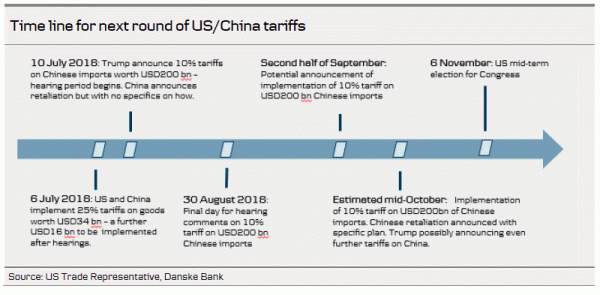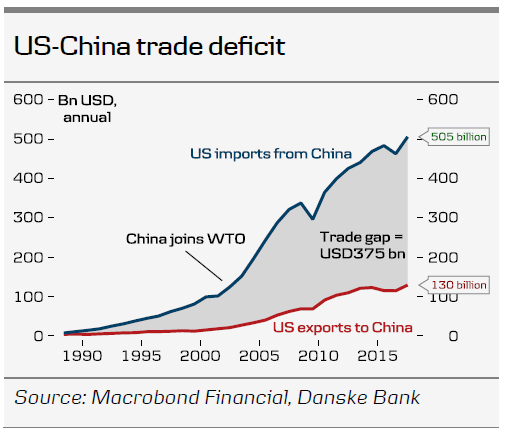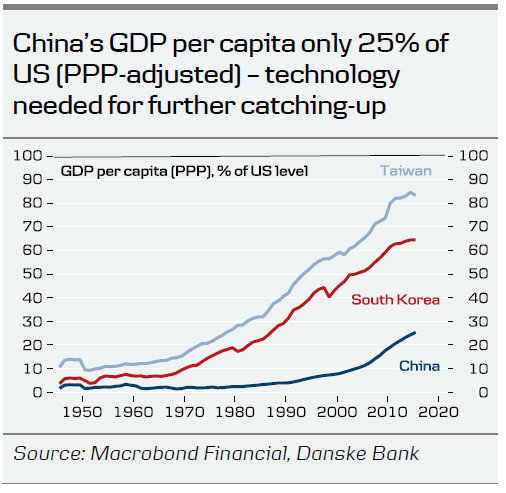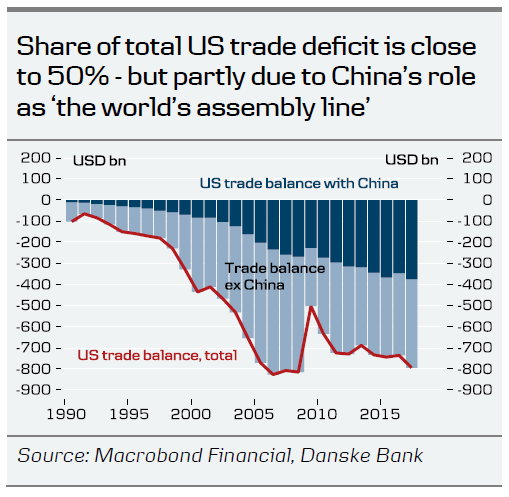- The trade deal between the EU and the US has left the question of whether a similar positive development could be seen between the US and China. However, since Trump left the negotiating table at the end of May, there has been no sign of trade talks between the US and China. We do not see any deal between the two countries this side of the mid-term elections in November.
- While Trump has very little backing in the US for a confrontation with the EU and other allies, he is under a lot of pressure to stick to a tough course with China.
- We believe we are heading for further escalation, when Trump is likely to implement 10% tariffs on another USD200bn worth of Chinese goods in mid- October. It is set to trigger Chinese retaliation with similar force — followed by a Trump warning of even more tariffs.
- The key challenge is that China has little more to offer than it has done already. While Trump’s strategy seems to be that more pressure will make China give him a better deal. This is unlikely to happen, in our view. It leaves a very uncertain outlook for how far the ‘tit-for-tat’ trade war can go.
The US-China trade spat continues to move in ebbs and flows but unfortunately with a clear direction: towards worsening. For now, the tensions have moved to the background. However, they are likely to come back into focus when the hearings for US tariffs on another USD200bn worth of Chinese imports are over and the tariffs kick in. This is likely to be in mid-October, just ahead of the mid-term elections on 6 November.
Listening to comments from both US and Chinese politicians, it is hard to see how a deal will be struck. They are too far from each other on the real cause of the US-China trade deficit, what China can do about it and what China is doing on intellectual property rights. More importantly, though, the US demand that China dismantles it’s ‘Made in China 2025’ strategy, which focuses on technology investments, is simply a no-go for China.
On the following pages, we give a summary of the key views on both sides as stated in interviews and statements over the past months.
The US view: stop cheating and stealing or face tariffs
#1: The ball is in China’s court
In a CNBC interview on 18 July, Trump’s economic advisor, Larry Kudlow, said there were no talks going on between US and China at the moment and that “In so far as we know, President Xi at the moment does not wish to make a deal… I think Xi is holding the game up… The ball is in his court“. Two days later Trump said in an interview also with CNBC that “Were ready to go to 500 [USDbn of Chinese imports]“. It doesn’t suggest to us that the US is in a mood to take the first step to restart negotiations.
#2: US can only win a trade war – and this is the time
The US administration signals it has the strongest hand in the trade war. In a tweet on 4 April Trump stated “When you’re already $500 Billion DOWN, you can’t lose!” His trade adviser Peter Navarro stated in a Fox News interview that “They depend on us a whole lot more than we depend on them“. Trump has clearly signalled that now is a good time to take the confrontation. Responding to a question in the CNBC interview he said very clearly “This is the time” referring to the strong US economy and the stock market. The fact that the Chinese economy is slowing and stocks have plummeted in China is likely encouraging Trump to stick to the strategy.
#3: Give us a fair deal or feel the heat from tariffs
Trump faced strong criticism in the US after the initial negotiations with China and he is under a lot of pressure from both fellow Republicans as well as Democrats to be tough with China. As a deal maker he needs something to put pressure on China and tariffs is the main tool in his tool box. The view was also reflected in the tweet on 24 July stating:
“Tariffs are the greatest! Either a country which has treated the United States unfairly on Trade negotiates a fair deal, or it gets hit with tariffs. It’s as simple as that…”
On 25 July Trump stated in another tweet that “China is targeting our farmers….as a way of getting me to continue allowing them to take advantage of the U.S. They are being vicious in what will be their failed attempt. We were being nice – until now! China made $517 Billion on us last year.”
#4: “We have been ripped off by China for a long time”
In the CNBC interview mentioned above, Trump repeated his campaign pledge that the US has been “ripped off by China for a long time“. The US administration points to higher Chinese tariffs relative to US tariffs, technology theft, state subsidies, non-tariff trade barriers and barriers to investments in China. On top of this the US wants China to back down from the “Made in China 2025” strategy, which focuses on big investments within technology over the coming years. In the announcement of new tariffs it said: “For over a year, the Trump administration has patiently urged China to stop its unfair practices… China has not changed its behaviour – behaviour that puts the future of the US economy at risk“.
#5: WTO is broken – bad deal negotiated by former presidents
Finally, the Trump is a big opponent of WTO and some reports mention he wants to pull out of it – although his advisers have so far kept him from doing it, see story in Business Insider. Larry Kudlow stated again on CNBC that “The world trading system is broken. WTO is broken“. As with other international deals Trump has withdrawn from, he is blaming it on previous US Presidents that made bad deals and he wants to fix it.
The China view: Trump wants tariffs and nothing can stop it
#1: The ball is in the US court
In the eyes of China, it was the US that left the negotiating table and therefore, the ball is in their court to restart negotiations. In response to Kudlow’s comments that Xi Jinping was holding up the negotiations, a Chinese Foreign Ministry spokeswoman called it “bogus accusations“. When Trump left the negotiation table in May, the Chinese spokeswoman said “Every flip-flop in international relations simply depletes a country’s credibility“. China will probably be cautious to go back to negotiations as they don’t see Trump as sincere in the trade talks.
That China has lost faith in a deal and is preparing for trade war is signalled by the recent policy easing of both monetary and fiscal policy with reference to “external uncertainty”. A China Daily editorial on 10 July, with the title “China ready and able to counter US trade attack”, said that “The timely release of supportive policies to strengthen the protection of the legitimate rights and interests of the country’s export-related enterprises and create a better investment environment shows that the Chinese authorities are expecting the maleficent actions of the United States to be both protracted and inexorable”.
#2: US wants to rob China of its future — concessions will never be enough
China has over the past year and during the negotiations accommodated a range of the critique points by the US. It has: 1) offered to buy more U.S. products of a value up to around USD100bn (the exact amount is not known) primarily within agriculture and energy; 2) reduced tariff levels (implemented 1 July); 3) further opened up for investments within both services and manufacturing; 4) vowed to increase efforts to protect intellectual property rights and 5) vowed to stop forced technology transfer.
However, on one point China will not meet the US. That is the demand to dismantle the “Made in China 2025” strategy, which focuses on investments within 10 sectors, primarily high-tech sectors. It sees the strategy as legitimate and necessary for China to avoid the ‘middle-income trap’, as numerous studies point to the need to invest in technology and innovation to avoid growth stalling at the current level of GDP per capita. Countries like Taiwan and South Korea, which have avoided the ‘middle-income trap’, all focused on technological upgrade at the development stage China is now at.
In the editorial in China Daily mentioned above it says: “…its [Trump administration’s] ultimate goal is not the rebalancing of trade to reduce the US’ deficit with China or even greater access to the Chinese market, its fundamental objective is to hinder China‘s development… It wants to rob China and the Chinese people of their future. Thus China will not be able to appease Washington no matter how it manages its trade or economy.”
#3: China to continue one-to-one retaliation to what is seen as unfair tariffs.
China sees the tariffs as illegitimate and the strategy has so far been to retaliate one-to-one, both in terms of amount and timing. China has not yet been specific about how it will respond if Trump implements the 10% tariff on another USD200bn of Chinese imports. But the Commerce Ministry stated after the US announcement that “To protect the core interests of the nation and its people, China’s government is, as in the past, forced to retaliate“. As Chinese imports of US goods is only USD130bn, it’s not able to match on amount. But there are a range of other ways it can hit the U.S. China can raise tariff rates to more than 10%, inhibit US investments in the US or start a consumer boycott (the latter has been used against Japan and South Korea previously).
#4: Trade deficit does not measure relative benefits of economic relationship
China disagrees with the US on both the causes of the trade deficit as well as the significance of the trade deficit as a measure of the relative benefits of US-Chinese economic cooperation.
First, the trade deficit is overestimated because it doesn’t take into account that only a small part of the export value from China is actually created in China. Today’s global supply chain often has China as the end point of production, or assembly, as components produced in other countries are imported to China, assembled and then shipped off to the U.S. and other countries. This makes Chinese exports vastly overestimated, because it is not based on the value that is added in China but instead on the full value of the product when it leaves China, see this paper from China Business Review for further elaboration on this issue.
Second, the US runs a USD40bn surplus on the service balance with China (a lot of it due to Chinese tourists in the US). There is no good reason why one should only look at goods’ trade, but not include service trade when gauging trade between two countries.
Third, sales of US subsidiaries in China are not captured by the trade balance. In 2015 US companies within China had a turnover of USD221.9 bn. There are no data for turnover of Chinese companies in the US but there are generally few Chinese companies in the US selling to US consumers. The turnover should be included when evaluating the relative benefits of US-China economic relations.
Fourth, the US could export to China if it didn’t have controls on exports of technology goods. Products that China has a high demand for as they are needed in the upgrade of its production. But these are protected for security reasons in the US. Fifth, the US trade deficit is to a large extent due to the low savings rate of the US, something that China cannot affect. A rising public deficit is only worsening the savings balance and will work to increase the trade deficit. For the same reason China cannot commit to a specific reduction of the trade deficit. Trump has asked for a reduction in the deficit of USD200bn by 2020 in the negotiations.
#5: China will not accept tariffs not based on WTO rulings
China does not accept tariffs that are based on the US’ own investigations and not on independent rulings by the WTO. On 29 June 2018, China released a white paper called “China and the World Trade Organization”, which concludes that China has “faithfully fulfilled its WTO Accession Commitments” and that China “firmly supports the Multilateral Trading System“.
Conclusion: A deal is still far away
With a still big gap in what Trump is demanding and what China is willing to give, we see little scope for a deal anytime soon. Lack of trust on China’s side and the fact that it has already eased policy to counter the negative effects of a trade war suggests that things still have to get worse.
We believe we at least have to get beyond the mid-term elections in the US on 6 November before any deal is back on the table. And even after that it is not clear how Trump is going to get a deal that he can present as a victory. China will not give in to demands to change its “Made in China 2025” strategy and this will keep the China hawks on both the Democratic as well as Republican sides in favour of a tough stance on China.
A caveat is, of course, that Trump sometimes changes his mind fast and could suddenly go back to the negotiation table again. The case with North Korea showed how he can turn quickly. But it was on the back of Kim Jong-Un making big concessions and we doubt that China will do the same.

















